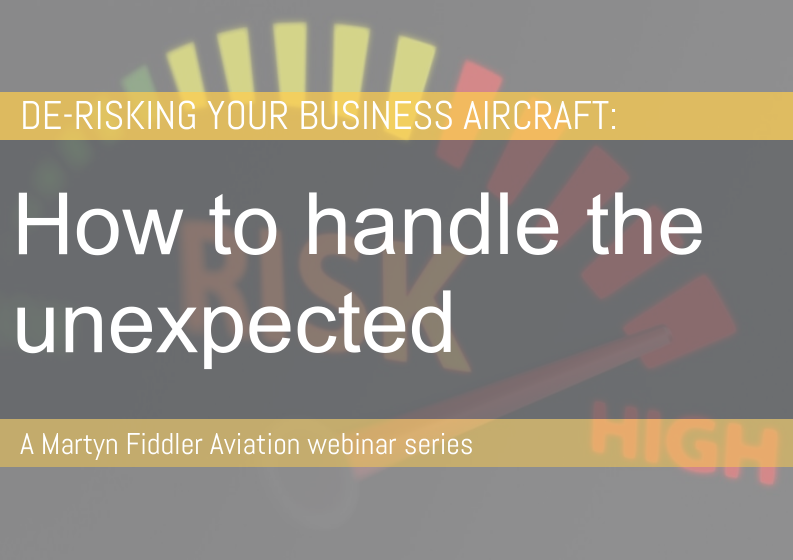
Understanding your avoidable risks on aircraft transactions
Understanding your avoidable risks on aircraft transactions
11 Mar 2021
We have identified 5 key risk zones in business aviation transactions: Mission, Team, Time, Expectation and Environment (discussed in our first webinar on risk management “5 simple steps to de-risk a business transaction”). There are risks that fall into each of these areas, but why are some of these risks more manageable than others?
To explain in simple terms, it is because some risks are known and some are not (or so unlikely to occur that it would be nearly impossible to plan for).
Manageable risks are ones that often occur on most transactions; they are therefore manageable because they are risks you can plan for and mitigate in the transaction. Unavoidable risks are the unknowns – the things you can’t foresee. In order to safely mitigate the increased risk that comes alongside the unknowns you will want to ensure you have an experienced team of professionals on your team who will be able to deal with anything unexpected in a timely and efficient manner because they have experience of these from previous work.
Top 5 risks which can be easily minimised or mitigated
1. What does the owner actually want?!
It might sound obvious, but knowing what the client actually wants can make a transaction run much more smoothly. The client might be interested in the date on which their first flight can take place after delivery, or they might want to operate the aircraft in a certain way, or perhaps they are looking for the aircraft to generate an income from third parties or they want to operate it exclusively for their own use? All of this information is really important to know from the outset so you can plan around the client’s requirements.
To make sure that you are responding in the best possible way to the client’s interests, setting out a transaction map with elements of particular importance highlighted can help to mitigate future issues arising. Also seeking input on areas of concern and/or interest can save time and money later on. Once a transaction map has been agreed, it can be altered, but the Martyn Fiddler Aviation team recommend trying to stick to it as best as possible to avoid delays and frustration down the line.
It is also crucial for clients and their representatives to understand “must haves” vs “nice to haves” in order to manage expectations. For example the client may have a particular registration mark in mind, but you need to ask whether the aircraft can be operated in the manner in which the client would like whilst using that registration? In essence, clear communication and organisation at the start of a transaction is key for the transactions success.
2. Co-ordinator and communicator
Communication is absolutely key throughout a transaction, as is the need for an experienced team of professionals to manage the transaction. A transaction needs a leader with experience to oversee the transaction map as there will be lots happening in different areas, all with different timescales and competing priorities. It is essential therefore to have a nominated person who has an overall view of the transaction who can co-ordinate the different teams involved to keep the right people updated and in the know about what is happening at any given moment. The transaction team leader should be directly communicating with the clients representative (or the client directly) throughout the transaction.
3. Compliance: Have the CDD ready to go
Just as the PPI and title/lien checks on the aircraft are incredibly important, knowing who you are dealing with on the other side of the transaction is also vital. This is underlined by a recent and ongoing US investigation which demonstrates the need for client due diligence (CDD) across the industry. The regulatory environment means that nearly everyone needs to provide CDD, so be sure to have it ready in advance to speed up the transaction. With regards to CDD documents, generally at a minimum the client should expect to be asked to provide a certified copy of their passport and utility bill but more will be required dependent on the client and their corporate structure.
Regulatory and legal requirements being what they are, it is important to establish the legitimacy of funds used to buy such expensive assets, therefore please don’t be surprised or offended when questions are asked about Source of Wealth and Source of Funds. It is important for all parties to comply with international legislation in this area and increasingly proof of any payments made may need to be provided.
To summarise, compliance is mandatory for nearly all transactions: so be prepared, save time by having the relevant documentation ready.
4. Seek and set up professional advice early
Aircraft will nearly always cross borders and regulatory and tax rules differ between regions and jurisdictions. Therefore it is crucial to seek experts in the key jurisdictions involved in the transaction. It is a good idea to source jurisdictional advisors at the start of a transaction to navigate any restrictions or tax liabilities early. Remember that when considering the different rules of one jurisdiction to the next, it is not just the aircraft ownership that needs to be considered, the client’s existing corporate structure may need to be considered too.
5. Time scales: Know what time can move and what cannot
Time is always of the essence in an aircraft transactions; everyone is always under pressure. You can speed up certain parts of a transaction by enrolling more people, however, there are some time scales which are absolute. For example if you are to fly your aircraft to Guernsey to complete a sale and then return to the UK, it will be important to understand there is actually a finite amount of time an aircraft can stay on the ground in Guernsey at the moment. Without understanding this the client and team could get caught out and face financial and other consequences. Being caught out adds time and expense in the middle of the transaction that wasn’t planned. It is crucial to know what elements of the transaction are time bound in order to minimise risk (and knowing that these change with the environment of the transaction).
Fact, fiction and fantasy
Confidentiality is important to me, why am I being asked to disclose my identity when selling or purchasing an aircraft by using the “back-to-back” method.
It is almost impossible to avoid disclosure of the parties in a transaction as the finance and corporate service entities involved will need to “look through” the transaction to all parties to properly carry out due diligence and security checks.
We are in a rush – can we do the paperwork afterwards?
Generally no. The paperwork, such as aircraft registry filings, finance and security documents, and legal opinions (to name a few), need to be prepared in advance and/or submitted at closing. The paperwork has to happen to ensure the transaction is legal and to reduce unforeseen risk to the client.
Do I have to pay tax?
Discussions about tax can take up a massive part of the overall transaction due to the values involved in business aviation. Ultimately you need to account for tax, but how tax it is accounted for will change transaction to transaction, there is simply no one size fits all. Getting a good team on the transaction early, involving an experienced tax advisor is crucial. Whether or not you can mitigate some or all of the tax payable will completely depend on client circumstances and be of great value to client, you want to ensure they receive the best possible advice.
Summary
- Similar risk areas occur on every transaction – by knowing what these are you have made the first step towards de-risking
- Some risks are more manageable and there are some easy things you can do to reduce risk
If you have any questions please do not hesitate to contact Heather at
If you want to see more from Martyn Fiddler, please follow us on linkedin: Martyn Fiddler








